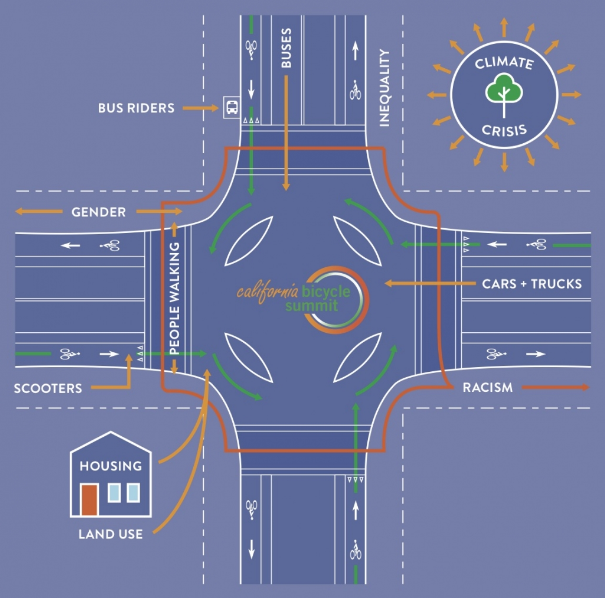Every two years, the California Bicycle Coalition hosts a gathering for people working on sustainable transportation issues throughout the state. This year the event will be held in downtown Los Angeles from October 15 to 17.
Every two years, I am challenged, inspired, surprised, refreshed, and tired out by the event. I have learned as much from unexpected, impromptu conversations in the corridors or outside under a tree as from the organized sessions. I took my first bike-share ride and my first e-bike ride at a CalBike summit - yeah, I know, old hat, but at the time it was anything but. Each time I go, I meet people I feel I should have known for years, people who are working on or want to work on or are just dreaming about making California a better place for everyone who rides a bike or wants to bike or ought to be able to ride a bike.
This year's summit promises to be no different. There is something - more than one thing - for everyone, no matter what their work or special interest or perspective. The schedule of events, available here, lists workshops and panel sessions, as well as tours, a party, a showing of the cargo bike movie Motherload, and other opportunities to meet and spend time with fellow bike believers.
Highlights include:
- A session focused on the challenges and promise of new ways of moving around cities. Calbike is especially interested in talking about how different modes can be made to work for everybody, not just the well-heeled and not just private companies looking to make money. To make it so, every aspect needs discussion, from fares to schedules, policies, regulations, and street design. Representatives from Uber and Lyft and some of the "disrupters" in this field will be on the panel along with representatives from community organizations dealing with their impacts.
- A discussion among city and regional DOT leaders who have succeeded in bringing big changes to their regions but also faced challenges and suffered setbacks in the process. Ryan Russo in Oakland and Seleta Reynolds in Los Angeles have shepherded new parking-protected bike lanes and planning processes to their respective cities, but have faced pushback at every stage. Why, despite having the right people in leadership positions, does progress remain so slow? How can advocates support them? The answers to this question will have ramifications for the future of the entire state, as we move into an era of new leadership at Caltrans and the California Transportation Commission.
The biggest problem with the summit has always been choosing which sessions to go to and which sessions have to be missed, because the schedule is packed.
There will be information on state programs and work being done at Caltrans:
- Proposed changes to the Active Transportation Program, which funds many bike-pedestrian projects. The ATP wants those projects to be "transformative" but what exactly does that mean?
- Caltrans' twelve districts are starting work on their Active Transportation Plans. What do they entail, why do they matter, how are they different and the same?
There will be inspiration and new ideas to grapple with:
- Youth leaders who created the West Long Beach Bike Toxic Tour will talk about how they got started and how they are helping empower their community
- Working with police to enhance bicycle and pedestrian safety rather than detract from it
- Grassroots bicycle advocacy by and for women
- The climate crisis and the bicycle
There will be key things to learn:
- Making equity an integral part of bike and pedestrian advocacy
- Spending money on safe bicycling infrastructure saves money on health care
- How to replace elected officials that block progress
- Communication strategies for advocates
- What the L.A. County Bicycle Coalition is learning from its community outreach
Outside of the sessions, which take up most of the three-day schedule, there are opportunities to get out and about with other bikey people. For example, several bike tours offer the chance to explore L.A. by bike and maybe transit, including downtown L.A., the arts district, the L.A. River Path, the SGV Bicycle Education Center, and Class I bike paths through Santa Clarita's mountains.






